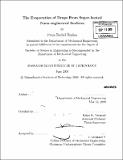| dc.contributor.advisor | Kripa K. Varanasi. | en_US |
| dc.contributor.author | Hughes, Fiona Rachel | en_US |
| dc.contributor.other | Massachusetts Institute of Technology. Dept. of Mechanical Engineering. | en_US |
| dc.date.accessioned | 2010-04-28T15:38:15Z | |
| dc.date.available | 2010-04-28T15:38:15Z | |
| dc.date.copyright | 2009 | en_US |
| dc.date.issued | 2009 | en_US |
| dc.identifier.uri | http://hdl.handle.net/1721.1/54478 | |
| dc.description | Thesis (S.B.)--Massachusetts Institute of Technology, Dept. of Mechanical Engineering, 2009. | en_US |
| dc.description | Cataloged from PDF version of thesis. | en_US |
| dc.description | Includes bibliographical references (p. 49). | en_US |
| dc.description.abstract | In pool boiling and spray cooling the Leidenfrost point marks the transition from nucleate boiling, in which the evaporating liquid is in contact with the surface, and film boiling, in which a layer of vapor separates the fluid from the surface. For a single evaporating drop, the Leidenfrost point occurs when the capillary and gravitational forces are surpassed by the upward pressure of the escaping vapor. This thesis develops an analytical model to predict the Leidenfrost point for a microstructured surface. The microstructure consists of a regular array of square posts geometrically defined by aspect ratio and spacing ratio. The vapor pressure is modeled using the momentum equation for flow in a porous medium. Varying the geometric parameters indicated that aspect ratio and spacing ratio must be optimized to achieve the maximum Leidenfrost temperature. For a water drop evaporating from a silicon surface, the maximum Leidenfrost temperature is predicted to occur with an aspect ratio of 1.3 and a spacing ratio of 1.5. [mu]L water drops were evaporated from a smooth surface made of silicon and porous surfaces made of aluminum oxide. The microstructure of the surfaces was different from that modeled, but increased wettability and higher Leidenfrost temperatures were observed as porosity increased. Recommendations for further research in this area are made. | en_US |
| dc.description.statementofresponsibility | by Fiona Rachel Hughes | en_US |
| dc.format.extent | 49 p. | en_US |
| dc.language.iso | eng | en_US |
| dc.publisher | Massachusetts Institute of Technology | en_US |
| dc.rights | M.I.T. theses are protected by
copyright. They may be viewed from this source for any purpose, but
reproduction or distribution in any format is prohibited without written
permission. See provided URL for inquiries about permission. | en_US |
| dc.rights.uri | http://dspace.mit.edu/handle/1721.1/7582 | en_US |
| dc.subject | Mechanical Engineering. | en_US |
| dc.title | The evaporation of drops from super-heated nano-engineered surfaces | en_US |
| dc.type | Thesis | en_US |
| dc.description.degree | S.B. | en_US |
| dc.contributor.department | Massachusetts Institute of Technology. Department of Mechanical Engineering | |
| dc.identifier.oclc | 556252591 | en_US |
